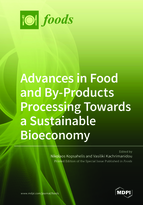Advances in Food and By-Products Processing Towards a Sustainable Bioeconomy
A special issue of Foods (ISSN 2304-8158). This special issue belongs to the section "Food Engineering and Technology".
Deadline for manuscript submissions: closed (15 July 2019) | Viewed by 48360
Special Issue Editors
Interests: industrial fermentations; food and by-products chemistry and analysis; valorization of renewable resources; biorefineries; food biotechnology, bioeconomy
Special Issues, Collections and Topics in MDPI journals
Interests: bioprocess; waste and by-products valorisation; biorefineries; probiotics; technoeconomic assesment; food packaging; microbial fermentations; biotechnology
Special Issue Information
Dear Colleagues,
The bioeconomy initially focused on resource substitution, including the production of biomass from various resources; its conversion, fractionation, and processing by means of biotechnology; and chemistry and process engineering towards the production and marketing of food, feed, fuel, and fibre. Nevertheless, although resource substitution is still considered important, the emphasis has been recently shifted to the biotechnological innovation perspective of the bioeconomy, in terms that ensure environmental sustainability.
It is estimated that around one-third of the food produced for human consumption is wasted throughout the world, posing not only a sustainability problem related to food security but also a significant environmental problem. Food waste streams, mainly derived from fruits and vegetables, cereals, oilseeds, meat, dairy, and fish processing, have unavoidably attracted the interest of the scientific community as an abundant reservoir of complex carbohydrates, proteins, lipids, and functional compounds, which can be utilized as raw materials for added-value product formulations.
This Special Issue focuses on innovative and emerging food and by-products processing methods for the sustainable transition to a bioeconomy era. Contributions addressing valorisation, the bioprocessing and biorefining of food industry-based streams, the isolation of high-added-value compounds, applications of resulting bio-based chemicals to food products, novel food formulations, economic policies for food waste management, and sustainability or technoeconomic analyses of the proposed processing methods are welcome in this Special Issue. We sincerely invite you to submit high-quality original research, review articles, and opinions that are related but not limited to the aforementioned topics.
Dr. Nikolaos Kopsahelis
Dr. Vasiliki Kachrimanidou
Guest Editors
Manuscript Submission Information
Manuscripts should be submitted online at www.mdpi.com by registering and logging in to this website. Once you are registered, click here to go to the submission form. Manuscripts can be submitted until the deadline. All submissions that pass pre-check are peer-reviewed. Accepted papers will be published continuously in the journal (as soon as accepted) and will be listed together on the special issue website. Research articles, review articles as well as short communications are invited. For planned papers, a title and short abstract (about 100 words) can be sent to the Editorial Office for announcement on this website.
Submitted manuscripts should not have been published previously, nor be under consideration for publication elsewhere (except conference proceedings papers). All manuscripts are thoroughly refereed through a single-blind peer-review process. A guide for authors and other relevant information for submission of manuscripts is available on the Instructions for Authors page. Foods is an international peer-reviewed open access semimonthly journal published by MDPI.
Please visit the Instructions for Authors page before submitting a manuscript. The Article Processing Charge (APC) for publication in this open access journal is 2900 CHF (Swiss Francs). Submitted papers should be well formatted and use good English. Authors may use MDPI's English editing service prior to publication or during author revisions.
Keywords
- Bio-economy
- Biorefineries
- Circular economy
- Bioprocesses
- Food waste and by-products valorization
- Food sustainability
- Food processing
- Food biotechnology
- Biocatalysis
- Bio-based products








